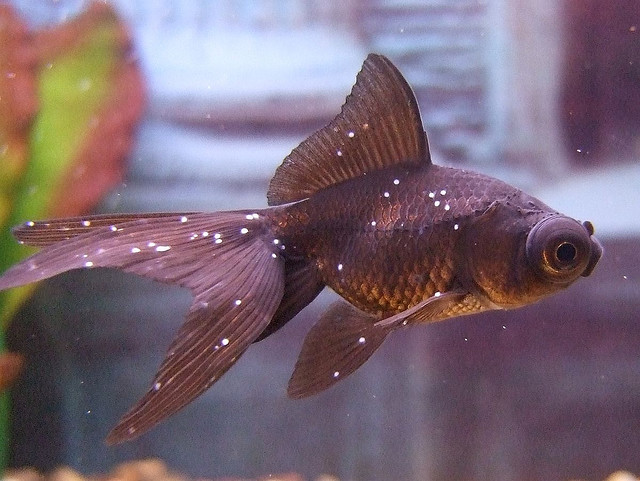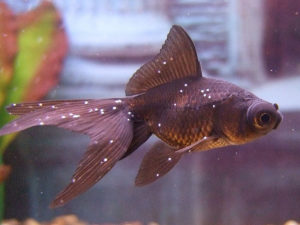

Whitespot (Ichthyophthirius multifiliis) is a common parasite found on fish in aquariums. It is an easy problem to spot, where a fish looks as if it has been sprinkled with salt – most commonly initially on its fins before spreading to all over the body. It can be caused by either stress or more commonly transferred from one aquarium to another on either a host or the water.
The following is extract of an excellent in depth article written by Shelli Wittig.
What Is White Spot?
The scientific name for this nuisance is Ichthyophthirius multifiliis, or “ich/ick” for short. It is the largest known ciliated protozoan found on fishes. It appears on the body and fins as tiny white dots resembling grains of salt; hence the other nickname, “white spot disease.” These white spots may join together to form white patches. Other signs of infestation can include excessive flashing (rubbing against the substrate or decorations), labored breathing, clamped fins, loss of appetite, lethargic and/or reclusive behavior.
Ich has three life stages, which are important to understand for proper diagnosis and treatment.
When the parasite is visible to the naked eye, it is fully developed “trophont” which has burrowed under the fish’s mucus coating where it is protected from chemicals (medication). It has likely been feeding on the body fluid of the fish for several days and has swelled to many times its original size. At common aquarium temperatures of 24-27ºC this feeding stage lasts only a few days, at which point the fully developed cyst drops off the fish as a tomont.
The tomont may swim for several hours before settling on and attaching to the substrate, a plant, or some other surface. During that time it is susceptible to chemicals and medication will be effective. Once attached, it begins its reproductive stage. It encysts and begins rapidly dividing. At this point, it is again immune to chemicals. Within a few days, hundreds of new organisms burst from the cyst, sprout cilia and start swimming in search of a host.
These are now referred to as thermonts or swarmers, and they must find a host within a few days or they will die. (For this reason, we know that even an aquarium heavily infested with Ich would be “clean” and safe for new fish after only a week or two without fish in the tank.) Medication is effective at this stage. Once the thermont attaches to a host and burrows in, it is referred to as a trophont and the cycle begins again. Unfortunately, with each cycle the number of organisms in the tank increases dramatically.
Left untreated, Ich is almost certainly fatal. Infected fish are weakened by the ever growing number of parasites feeding on them. Secondary bacteria and fungi attack more easily. Trophonts on the gills eventually restrict oxygen flow and respiration is hindered. The ailing fish will ultimately succumb either to the infestation itself or a secondary condition.
How Do I Prevent It?
It is a commonly held belief that the Ichthyophthirius organism is always present in your aquarium and needs only the right opportunity, such as stress resulting in a weakened immune function, to attack your fish. Surprisingly, I found no scientific data to support that claim. Credible sources state that there is no long-term dormant stage this parasite can exist in. While its lifecycle is longer at low temperatures (like that of an outdoor pond in a cooler climate), at average home aquarium temperatures this parasite would likely complete a lifecycle in less than a week. Considering that a single organism produces hundreds (if not thousands) of offspring, the logical question is “where would they all go?” Dr. Peter Burgess, writing for Practical Fishkeeping magazine (who also co-authored the book entitled A to Z of Tropical Fish Diseases and Health Problems), refers to the dormant concept as “rubbish.”
The proliferation of this myth could be due to the fact that it is possible for a strong, healthy fish to resist severe infestations, especially if it was infected previously and developed some resistance. While the organisms attach easily to the gills of most fish (where they cannot be seen), the body may be sufficiently protected by a tougher mucus coating. Such a fish could serve as an asymptomatic carrier; potentially hosting many lifecycles without showing any visible signs. When introduced to a new tank it brings the parasite with it. Scaleless fish such as loaches and catfish often show symptoms first, but most likely every fish in the tank will eventually be infected; if not visibly on the body, on the gills at the very least.
It stands to reason that a stressed fish with a weakened immune function is an easy host, but only if the parasite is present in the tank to begin with. That brings us back to how to prevent it, now that we know it is not lurking in every aquarium waiting to strike. Here are few guidelines:
Never buy fish from a tank where any fish show signs of disease.
If you do not quarantine (not everyone has an extra tank set up), after floating the bag and adding small amounts of your tank water to acclimate the new fish, gently empty the bag into a net (working over a bucket) and then place the netted fish in the aquarium. Never add the water from the travel bag to your aquarium as it could contain Ich thermonts or other dangerous organisms. Still, your fish could have trophonts on the gills or on the body which have not swelled enough yet to be visible. You’re gambling with the health of all your fish if you don’t quarantine.
If you keep multiple tanks, use separate nets for each tank and/or let your net dry completely between uses. Ich cannot survive being dried out.
Buy plants only from tanks without fish, or quarantine plants for 5-7 days without fish, or bathe plants in potassium permanganate before putting them in the main tank (unfortunately this can be hard on the plants).
Use a UV Sterilizer if your budget allows it.
If your tank does become infected, be accurate and thorough with treatment to ensure total eradication. It only takes a single surviving trophont to reproduce and start the whole ugly process again.
How Do I Treat It?:
1. Don’t panic.
2. Do a normal water change by vacuuming the bottom of the aquarium by about 25% of the total capacity. (Gravel vacuuming is also helpful to remove as many tomonts as possible before they can release offspring.)
3. Raise the temperature of the aquarium (if you have a heater) to between 28ºC and 30ºC.
4. Come down to your local Aquarium Shop and buy White Spot Treatment.
A treatment usually lasts 3 days – but refer to your specific brand’s bottle for directions. Cold water tanks usually need to be done twice or even three times we find before the parasite is completely eradicated.
There are two schools of thought regarding raising the temperature of the water to treat ich.
The first approach is used simply to speed up the lifecycle of the parasite, since whatever medication you choose will only be effective on the free-swimming tomonts and thermonts. It is understood that at temps above 24ºC, for example, an entire lifecycle can be complete in around 3 days.
The second approach is to actually destroy the organism with heat, and can be combined with the salt treatment below. Data suggests that most strains of Ich cannot reproduce at temperatures above 29ºC. To use this treatment approach raise the temperature to 29ºC, while maintaining strong continuous surface agitation to oxygenate the water. This is extremely important because water holds less O2 at higher temperatures.
You can angle powerheads up toward the surface, or lower your water level to get a little extra splash from your filter return. As with any treatment, observe your fish closely for signs of stress (labored breathing, erratic behavior) and reduce the temperature slowly if necessary.
The adjusted temperature should be maintained for approximately 3 days after all signs of the parasite have disappeared. To be certain, continue treatment when the spots have gone away. This is good practice because we know that they are visible only as a trophont on the body of the host, and not during the reproductive or free-swimming stage. We also know that trophonts on the gills are impossible to see.
Aquarium Salt is frequently recommended for treating a myriad of fish diseases, especially those involving external protozoa and fungi. I teaspoon of aquarium salt can be added per 5 litres of water.
At the end of the treatment, you can do a normal water change with dechlorinated unsalted water to reduce the salinity back to normal if you wish.
Traditional Medications
As stated previously, there are many products available for treating ich. Whatever you choose, be sure to:
Read the label thoroughly for dosage information, special instructions, and warnings related to your own health and that of your plants, invertebrates, and scaleless or sensitive species of fish. For example, Loaches, Tetras, Baby Fish and Invertabrates can only be half dosed with medication.
Remember to remove any carbon from your filter if necessary.
Continue treatment for the duration advised. Because of the lifecycle of the parasite it is critical that you continue treatment for a minimum of 3 days after any visible signs of Ich can be detected. Do not discontinue treatment when the spots go away. If the instructions advise you to retreat, do so.
Waterlife produce an excellent product called Protozin that is brilliant at removing the parasites from the aquarium. There are other products that work almost as well.

Leave a Reply
You must be logged in to post a comment.